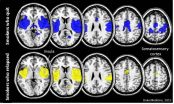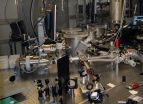Brains of smokers who quit successfully might be wired for success
2015-05-13
(Press-News.org) DURHAM, N.C. - Smokers who are able to quit might actually be hard-wired for success, according to a study from Duke Medicine.
The study, published in Neuropsychopharmacology, showed greater connectivity among certain brain regions in people who successfully quit smoking compared to those who tried and failed.
The researchers analyzed MRI scans of 85 people taken one month before they attempted to quit. All participants stopped smoking and the researchers tracked their progress for 10 weeks. Forty-one participants relapsed. Looking back at the brain scans of the 44 smokers who quit successfully, the researchers found they had something in common before they stopped smoking -- better synchrony (coordinated activity) between the insula, home to urges and cravings, and the somatosensory cortex, a part of the brain that is central to our sense of touch and motor control.
"Simply put, the insula is sending messages to other parts of the brain that then make the decision to pick up a cigarette or not," said Merideth Addicott, Ph.D., assistant professor at Duke and lead author of the study.
The insula, a large region in the cerebral cortex, has been the subject of many smoking cessation studies that show this area of the brain is active when smokers are craving cigarettes, said Joseph McClernon, Ph.D., associate professor at Duke and the study's senior author. Other studies have found that smokers who suffer damage to the insula appear to spontaneously lose interest in smoking.
"There's a general agreement in the field that the insula is a key structure with respect to smoking and that we need to develop cessation interventions that specifically modulate insula function," McClernon said. "But in what ways do we modulate it, and in whom? Our data provides some evidence on both of those fronts, and suggests that targeting connectivity between insula and somatosensory cortex could be a good strategy."
Neurofeedback and transcranial magnetic stimulation, used to improve depression, are two treatments that modulate brain activity. With the findings in this study, researchers now have more information on where to further investigate, McClernon said.
"We have provided a blueprint," McClernon said. "If we can increase connectivity in smokers to look more like those who quit successfully, that would be a place to start. We also need more research to understand what it is exactly about greater connectivity between these regions that increases the odds of success."
INFORMATION:
In addition to Addicott and McClernon, study authors include Maggie Sweitzer; Brett Froeliger; and Jed Rose.
The researchers received funding from the National Institute on Drug Abuse (R01 DA025876; K01 DA033347). McClernon is also a site principal investigator on an investigator-initiated grant (GRAND) from Pfizer, Inc.
[Attachments] See images for this press release:

ELSE PRESS RELEASES FROM THIS DATE:
2015-05-13
Beekeepers across the United States lost more than 40 percent of their honey bee colonies during the year spanning April 2014 to April 2015, according to the latest results of an annual nationwide survey. While winter loss rates improved slightly compared to last year, summer losses--and consequently, total annual losses--were more severe. Commercial beekeepers were hit particularly hard by the high rate of summer losses, which outstripped winter losses for the first time in five years, stoking concerns over the long-term trend of poor health in honey bee colonies.
The ...
2015-05-13
MANHASSET, NY -- The Feinstein Institute for Medical Research, the research arm of the North Shore-LIJ Health System, and SetPoint Medical Inc., a biomedical technology company, today released the results of research on the therapeutic potential of vagus nerve stimulation. In a paper published by Bioelectronic Medicine, Kevin J. Tracey, MD, and his colleagues at the Feinstein Institute, explore how low-level electrical stimulation interacts with the body's nerves to reduce inflammation, a fundamental goal of bioelectronic medicine.
Prior to this study, it was not understood ...
2015-05-13
Scientists at The University of Manchester have made an important discovery about how certain cells stick to each other to form tissue.
The team from the Faculty of Life Sciences studied how cells in the skin and heart are bound together through structures called desmosomes. They wanted to understand how these junctions between the cells in the tissue are so strong.
Desmosomes are specialised for strong adhesion. They bind the tissue cells together to resist the rigours of everyday life and their failure can result in diseases of the skin and heart, including sudden ...
2015-05-13
A part of the performance degradation mechanism of the advanced, electrodeless, helicon plasma thruster with a magnetic nozzle, has been revealed by the research group of Dr. Kazunori Takahashi and Prof. Akira Ando at Tohoku University's Department of Electrical Engineering.
An electric propulsion device is a main engine, and a key piece of technology for space development and exploration. Charged particles are produced by electric discharge and accelerated, i.e. momentum is transferred to them via electromagnetic fields. The thrust force is equivalent to the momentum ...
2015-05-13
Digital signatures are mechanisms for authenticating the validity or authorship of a certain digital message and they aim to be digital counterparts to real (or analog) signatures. The concept was introduced by Diffie and Hellman in 1976. Notice that, when certified, digital signatures have the same legal power as traditional signatures.
With the advent of quantum computation new threats to security became a near future reality and all known digital signatures schemes are vulnerable, compromising fundamental properties of signature schemes: authenticity and authorship ...
2015-05-13
Chicago (13 May, 2015)- In the latest issue of the Bulletin of Atomic Scientists, published by SAGE, experts from the United States, Russia, and China present global perspectives on ambitious nuclear modernization programs that the world's nuclear-armed countries have begun.
In the latest edition of the Bulletin's Global Forum, Georgetown University professor Matthew Kroenig argues that:
"Failure to modernize would not contribute to disarmament - but more than that, it would be irresponsible. A crippled US nuclear force would embolden enemies, frighten allies, generate ...
2015-05-13
The recombination of electron shells in molecules, taking just a few dozen attoseconds (a billionth of a billionth of a second), can now be viewed "live," thanks to a new method developed by MIPT researchers and their colleagues from Denmark, Japan and Switzerland. An article detailing the results of their study has been published in the journal Nature Communications.
In recent years, scientists have learned how to study ultrafast processes taking place at the atomic and molecular levels, and research in this field is expected to yield some very important results. In ...
2015-05-13
This news release is available in German. Chloroplasts are the solar cells of plants and green algae. In a process called photosynthesis, light energy is used to produce biochemical energy and the oxygen we breathe. Thus, photosynthesis is one of the most important biological processes on the planet. A central part of photosynthesis takes place in a specialized structure within chloroplasts, the thylakoid membrane system. Despite its apparent important function, until now it was not clear how this specialized internal membrane system is actually formed. In a collaborative ...
2015-05-13
Amsterdam, May 13, 2015 - A new family of molecules that kill cancer cells and protect healthy cells could be used to treat a number of different cancers, including cervical, breast, ovarian and lung cancers. Research published in EBioMedicine shows that as well as targeting and killing cancer cells, the molecules generate a protective effect against toxic chemicals in healthy cells.
Cells can become cancerous when their DNA is damaged. Many different things can cause DNA damage, including smoking, chemicals and radiation; understanding exactly what happens at the point ...
2015-05-13
London/Zurich, May 13, 2015: Children in European countries tend to report higher levels of satisfaction with their friendships while children in African countries tend to be happier with their school lives. Children in northern European countries are particularly dissatisfied with their appearance and self-confidence. Most of the 50,000 children in the 15 countries rated their satisfaction with life as a whole (on a scale from zero to ten) positively, but the percentage of children with very high well-being (10 out of 10) varied from around 78% in Turkey and 77% in Romania ...
LAST 30 PRESS RELEASES:
[Press-News.org] Brains of smokers who quit successfully might be wired for success



